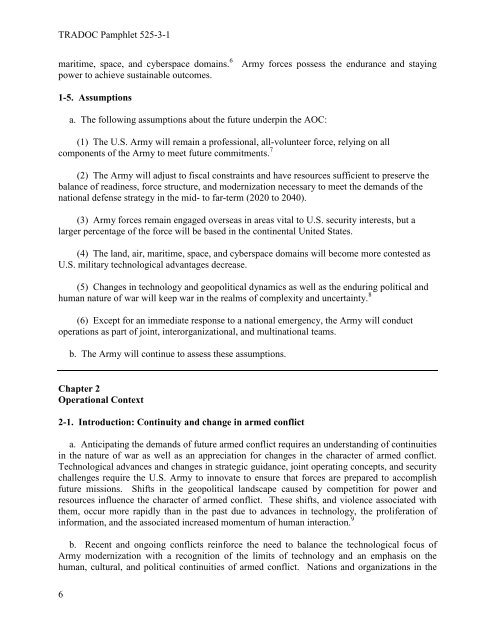TP525-3-1
TP525-3-1
TP525-3-1
Create successful ePaper yourself
Turn your PDF publications into a flip-book with our unique Google optimized e-Paper software.
TRADOC Pamphlet 525-3-1<br />
maritime, space, and cyberspace domains. 6<br />
power to achieve sustainable outcomes.<br />
Army forces possess the endurance and staying<br />
1-5. Assumptions<br />
a. The following assumptions about the future underpin the AOC:<br />
(1) The U.S. Army will remain a professional, all-volunteer force, relying on all<br />
components of the Army to meet future commitments. 7<br />
(2) The Army will adjust to fiscal constraints and have resources sufficient to preserve the<br />
balance of readiness, force structure, and modernization necessary to meet the demands of the<br />
national defense strategy in the mid- to far-term (2020 to 2040).<br />
(3) Army forces remain engaged overseas in areas vital to U.S. security interests, but a<br />
larger percentage of the force will be based in the continental United States.<br />
(4) The land, air, maritime, space, and cyberspace domains will become more contested as<br />
U.S. military technological advantages decrease.<br />
(5) Changes in technology and geopolitical dynamics as well as the enduring political and<br />
human nature of war will keep war in the realms of complexity and uncertainty. 8<br />
(6) Except for an immediate response to a national emergency, the Army will conduct<br />
operations as part of joint, interorganizational, and multinational teams.<br />
b. The Army will continue to assess these assumptions.<br />
Chapter 2<br />
Operational Context<br />
2-1. Introduction: Continuity and change in armed conflict<br />
a. Anticipating the demands of future armed conflict requires an understanding of continuities<br />
in the nature of war as well as an appreciation for changes in the character of armed conflict.<br />
Technological advances and changes in strategic guidance, joint operating concepts, and security<br />
challenges require the U.S. Army to innovate to ensure that forces are prepared to accomplish<br />
future missions. Shifts in the geopolitical landscape caused by competition for power and<br />
resources influence the character of armed conflict. These shifts, and violence associated with<br />
them, occur more rapidly than in the past due to advances in technology, the proliferation of<br />
information, and the associated increased momentum of human interaction. 9<br />
b. Recent and ongoing conflicts reinforce the need to balance the technological focus of<br />
Army modernization with a recognition of the limits of technology and an emphasis on the<br />
human, cultural, and political continuities of armed conflict. Nations and organizations in the<br />
6


